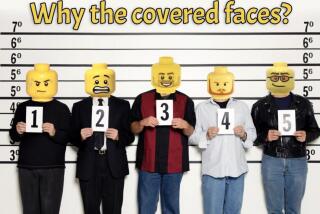‘The Lego Movie’: Building a postmodern, tongue-in-cheek toy film
Early in the development of “The Lego Movie,” Jill Wilfert, the executive who oversees Lego’s licensing efforts in Southern California, had a question for her bosses at company headquarters in Denmark: Can we have a character die?
“It wasn’t something we ever had to really think about before,” Wilfert said. “But we had to think about it now.”
Their conclusion was yes, and it became one of a number of freedoms the company allowed Warner Bros., producer Dan Lin and writer-directors Phil Lord and Chris Miller in creating the most freewheeling and reference-packed picture to come out of film’s branded-movie era.
PHOTOS: Actors who’ve been turned down for famous roles
“Lego”--which as of Thursday had garnered a rare 100% Fresh score on Rotten Tomatoes and was expected to open upward of $50 million this weekend--is a rare Big Hollywood entertainment with a playful subversiveness, the world’s first postmodern toy film. Its very existence is an object lesson of sorts — evidence of how the right mix of filmmaker whimsy, corporate latitude and, perhaps, Hollywood newbieness can align for something original in a culture of big-budget sameness.
Hollywood has been riding a toy wave since the first “Transformers” picture in 2007, with franchises both successful (“G.I. Joe”), stalled (“Battleship”) and stuck in development (“He-Man”). But where most films have used a toy as little more than a pretext for a big action movie, “Lego” takes a different approach.
Themes inherent to the product--the tension between following instructions and going your own way--form the film’s spine. With a unique visual look that includes splashy 3-D colors and limited points of articulation, characters in “The Lego Movie” also look and move uncommonly like the toy.
But most surprisingly, “The Lego Movie” pokes fun at the very idea of a toy film.
“There are thematic things that you wouldn’t expect to see in a kids movie that we feel like we’re getting to say,” Lord said.
Or as Alison Brie, who costars as the movie’s hybrid unicorn-feline Unikitty, puts it: “With a lot of animated movies, there are jokes for adults. But the idea here extends past the comedy so that there are a lot of conceptual things for them too.”
BEST MOVIES OF 2013: Turan | Sharkey | Olsen
The movie portrays a world in which the evil president Lord Business (voiced by Will Ferrell) rules over a land made numb by inane reality TV and fast-food giveaways. The rare independent-minded type, known as a Master Builder, is drowned out by the conformists.
Landing with a jolly shake of his mini-arm is Emmet (Chris Pratt), a cheerful rule-follower whiling away his days in an anonymous construction job. (“I guess Phil and Chris captured something about my real personality,” Pratt said, jovially.) Soon, though, Emmet meets the rebel spirit Wyldstyle (Elizabeth Banks), who mistakes him for a Neo-like chosen one and corrals him into adventures through various Lego worlds.
CRITICS’ PICKS: What to watch, where to go, what to eat
As Emmet and Wyldstyle embark on their frenetic adventures — filled with references, asides and non sequiturs (Siri jokes, anyone?) — they run into characters from modern Lego sets and pop culture at large. Many are Warner Bros. and DC Comics entities — Harry Potter, Gandalf, Batman (played with a suave jerkiness by Will Arnett). Others, though, come licensed from the vaults of other companies, such as the Teenage Mutant Ninja Turtles, the heroes of “Star Wars” and NBA stars such as Shaquille O’Neal.
Though the effect is to advertise the branded Lego sets that have become the company’s bread and butter, much of this is handled tongue-in-cheek, a piling on of the marketing while winking at the idea of piling on the marketing. A quick cutaway to Lego sets that feels like product placement is in fact a self-deprecating reference to failed lines like Clown Town.
“What I love about what Lego let us do is that they let us have a wink at themselves,” said producer Lin. “‘Is that product placement? No, it’s actually a joke about product placement.’”
Epitomizing that have-it-both ways postmodernism: the movie’s theme song, “Everything Is Awesome,” an impossibly sunny number sung by Tegan and Sara and Lonely Island that is embraced by Emmet--and which manages to satisfy animation audiences’ need for infectious synth-pop and simultaneously making fun of that very need.
How a movie this unusual came to be assembled by a studio and a toy giant is a question as intricate as one of its trademark kits.
For years, Lego — the world’s second-largest toy company but, as a privately held Scandinavian firm, rooted in a culture physically and spiritually far from Hollywood — resisted a movie. The company eventually came to back a video game and a pair of cable series, but it turned down numerous movie pitches it thought didn’t fit with its brand. And it rejected the Hollywood agency-brokered deals that for a time gripped Hasbro and other toy giants.
That began to change about five years ago, when the Warner Bros.-affiliated producer Lin brought on writers Dan and Kevin Hageman, up-and-comers who had an affinity for the toy based on their own childhood experiences.
The trio traveled to Lego headquarters in Billund, Denmark, and gave a pitch for a film, one that wouldn’t just be a blow-’em-up in which the heroes were rehashed intellectual property but something more sweet and personal. Chief Marketing Officer Mads Nipper and his colleagues — a group of such a whimsical bent that its members handed out “business cards” that were minifigures emblazoned with contact info — were hooked, and gave them a standing ovation
Soon, Lord and Miller, known for family fare such as “Cloudy With a Chance of Meatballs” and grown-up entertainment such as “21 Jump Street,” were hired and set about giving the movie its irreverent comedy feel.
Also brought on under the film’s relatively modest budget (less than $70 million) was Australian visual-effects company Animal Logic. Lord and Miller wanted the movie to be photo-realistic and avoid animation’s anything-goes rules of motion so the characters really felt like Lego. (One of the jokes is that romance in the Lego movie universe is consummated by the anatomically incorrect minifigures linking scooped hands, because, really, what else can they do?)
All this, filmmakers said, came together to become something surprisingly, well, handmade given the corporate interests.
“We grew up on the Warner Bros. cartoons that didn’t talk down to kids,” said Miller. “You know, the stuff that had adult humor about opera and existential crises for Daffy Duck. That’s what we wanted to do here, and that’s what we feel we got to do.”
Still, there was some tension. Warner Bros. executives, according to a person familiar with the movie’s development who asked for anonymity because of the sensitivity around the issue, were less keen on a whopping third-act twist that would be considered heavily meta even in an independent film. Though the finale would bring a smile to the face of many adults, executives felt it might be too subtle for younger viewers. Lord and Miller pushed for it, and won.
PHOTOS: Celebrities by The Times
Lego had its own objections to some elements — the company didn’t want guns, for instance. “I’m sure Phil and Chris would have wanted more playfulness,” Wilfert said, offering a small laugh. “But there were some things we knew we couldn’t do because they didn’t fit with our brand.”
Lord acknowledged the delicate balance between casting Lego in a good light and poking fun at it. “Some of those conversations were difficult,” he said. But he added that they were able to turn hurdles into strengths. The gun issue, for instance, was resolved by having the movie’s chief weapon become industrial-strength glue. Because what could be more scary for minifigures than the idea of getting stuck together?
Most notably, all the principals said, they agreed on the basic mission. “We all wanted to make a movie that captured what it was like to play with Lego,” Wilfert said.
Could that take on a truly postmodern form? “Maybe someone will make a Lego trailer out of ‘The Lego Movie,’” said Miller, referencing what has become a stop-motion YouTube phenomenon for some of Hollywood’s biggest movies. It may only be a matter of time.
eature-well” />
More to Read
Only good movies
Get the Indie Focus newsletter, Mark Olsen's weekly guide to the world of cinema.
You may occasionally receive promotional content from the Los Angeles Times.







